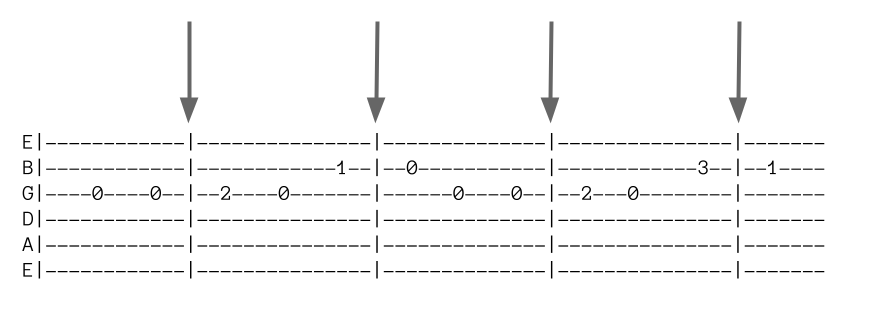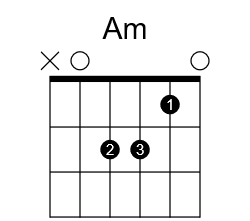How to Read Guitar Tab
Guitar tab (short for tablature) is a way to write out music for the guitar or bass, that doesn’t use traditional music notation. Learning how to read guitar tab is far easier. It’s also easier to write it.
Tab is like having someone saying -“put your finger on that string on that fret, now put your finger on this string on this fret.” What it doesn’t do, is tell you which fingers to use when. Very often, it also doesn’t tell you how long to hold the note or chord. Tab, in its simplest form, does not include rhythm. Either you already know how it should sound or you have a recording handy to listen to for reference.
There is a hybrid of tab and rhythm notation used in some guitar magazines, books, and websites, and it’s really the best of both worlds. However, that assumes you know how to read rhythm, so we’re not going to cover that here.
Before I get into the lesson, if you’d prefer to watch a video, I’ve created one for you:
An Example
Here is simple example of the tab for some of the melody from “Happy Birthday to You”:
E|------------|---------------|--------------|---------------|-------
B|------------|------------1--|--0-----------|------------3--|--1----
G|----0----0--|--2----0-------|------0----0--|--2---0--------|-------
D|------------|---------------|--------------|---------------|-------
A|------------|---------------|--------------|---------------|-------
E|------------|---------------|--------------|---------------|-------
It might look a little confusing at first, but it won’t be in a few seconds.
Reading the Tab
One way to think of tab is as if you’re laying your guitar on your lap and looking down at the neck.
Tab consists of six horizontal lines, one per string of the guitar. They are in the same order the appear on your guitar, from low to high, E-A-D-G-B-E. In tab, the highest pitch string – the first string or high E – is at the top of the tab. The lowest string, the sixth string, the low E, is on the bottom of the tab.
The numbers in the tab tell you on what fret you should place your finger – a zero means play the open string. They do not tell you which finger to use. You could use any of them. Context – the notes before and after – will be the determining factor.
Vertical Lines

The vertical lines group the notes together to express either measures (which might help you figure out the rhythm) or can just be a convenient way to say these notes go together as a kind of discrete musical thought. Not every tab will have the vertical lines.
A Walk Through of How to Read Guitar Tab
So looking at the first few notes in the example :
- Play the open G string (the 3rd string on your guitar).
- Play it again.
- Next, play the second fret, on the G string.
- Then play the open G string.
- Play the first fret on the B (2nd string).
I chose “Happy Birthday to You” as an example because it is widely known.
However, as you can see, because nothing tells you how long to play the notes, if you don’t know the melody, you may or may not play it the “right” way.
Chords
The above example is for a single line melody, lead, solo, etc.
Notes to be played together – as in a chord – are stacked. For example:
E|---------0-----------
B|---------0-----------
G|---------0-----------
D|---------2-----------
A|---------2-----------
E|---------0-----------If you’re familiar with the chord above, you might recognize it as an E minor. If it’s new to you, that’s OK. Just know that notes that are to be played simultaneously, as in a chord, are written in this stacked format.
To follow the tab in this case:
- Place a finger on the 2nd fret of the A string (the 5th string).
- Then, place a finger on the 2nd fret of the D string (the 4th string).
- The other strings are left open.
- Play all of the strings.
If there’s no fret indicated and no 0, don’t play the string. For example:
E|---------0-----------
B|---------1-----------
G|---------2-----------
D|---------2-----------
A|---------0-----------
E|---------------------This chord is an A minor chord.
The tab tells us to:
- Place a finger on the 2nd fret of the D string (the 4th string).
- Then, place a finger on the 2nd fret of the G string (the 3rd string).
- Finally, place a finger on the 1st fret of the B string (the 2nd string).
- Play only the strings that have either a 0 or a fret number indicated.
Deciding Which Finger to Use to Fret a Note
A chord diagram tells you which fingers to use:

Unlike a chord diagram, tab only shows you the position, it doesn’t tell you which finger to use.
When you’re first starting out, this can sometimes trip you up. Experience will help you figure out the most efficient fingerings based on the context – particularly with single note lines.
In the meantime, if you have a teacher they can help you with this. If not, for chords, you can find chord diagrams in books and online. For single-note lines, check out videos online of someone playing the song you want to learn – you might have an “a-ha!” moment seeing them play a passage you find tricky.
What next?
There are many more symbols for special techniques but these are the basics of how to read guitar tab and will cover most of the tab you run into.
If you have any questions or you are interested in a free trial lesson, click the button below.